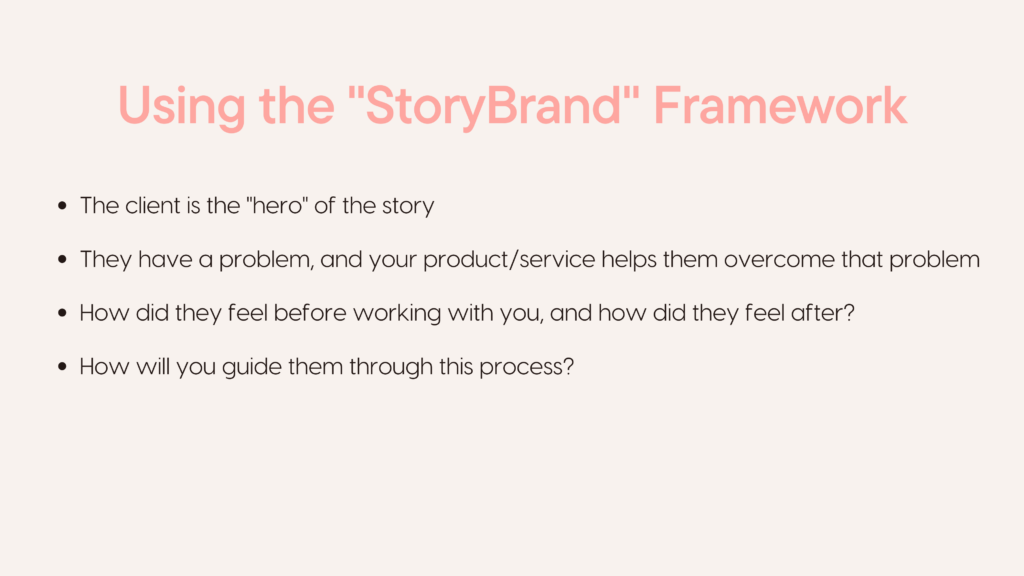Writing content can be one of the most daunting tasks when it comes to building your website. But it’s also arguably the most important! Today we’re talking about how to improve your website copy! Check out the video tutorial below, or keep reading!
I grew up writing stories, and after working in the news industry, writing even more stories, I decided to start my own photography business. After diving deep into business and marketing tactics, I realized it all comes full circle. That my love for storytelling (in writing and photography), fits perfectly into my love of online marketing and web design. Stories are vital to your business, and to your website!
In this video and blog post, I will give you guidelines to use to judge your own website copy, and action steps you can take to improve your website copy immediately.
The worst thing you can do on your website

One of the worst things you can do for your website is cause confusion. And the last thing you want a potential customer to be confused about? What you do!
Make sure your website clearly says/shows what you DO immediately. You only have 10-20 seconds to make a first impression. By then, your audience decides if they’re interested or not. If they don’t know what you do, or who you do it for, they’ll be confused and gone before you even have a chance to explain.
A few website copy guidelines:

- Make sure your copy is conversational, and easy to understand (explain what you do out loud, as if you were talking to someone about it. Does your website reflect that conversational tone?)
- Make sure your navigation is clear and concise. Don’t use confusing terms. Your customers need to understand where to go immediately.
- Can I see why you do what you do? Or why your business exists? Define your “why” behind what you do, and include that in your messaging. People respond to and make decisions based on emotions. And they don’t really care about your product/service until they know why you do it!
A really awesome resource for this is Simon Sinek’s book “Start with Why”. You can read it or listen to it on Audible.
What you can do to improve your website content today
When I work with branding clients, I focus a lot on personal brand and building that “KLT” (know-like-trust) factor. Stories are the best way to connect with your audience. To make yourself and your business relatable. You want to share personal stories with your audience, as well as the stories behind your business.
And perhaps most importantly, share the stories of the people you serve! Your potential clients will be able to put themselves in your current clients’ shoes, and envision themselves using your service or product. People are way more likely to buy from people they feel like they know and can trust, and stories are a great way to establish that.
Defining your client story
- Write the story of one of your clients (can be fictional, but preferably a true client story!). What journey do they take with your product or service? How did they feel before they found you (fears, concerns, problems)? How did they use your product or service, and then how did they feel afterwards?
- Use that story as the foundation of your messaging on your home page. Walk them through that story on your website with simple, clear messaging.
- For more on this, read Donald Miller’s “Building a Story Brand” for tips you can implement immediately! He also has a podcast and website template you can use at storybrand.com.
Here are a few examples of how you can implement your clients’ story into your website:
- Write out a short list of problems your client has before they work with you, then right next to it, a short list of resolutions they have after working with you
- Create a breakdown of your process (the steps your client goes through to get to the results)
- Design a list of what’s included with your service, or the promise you keep when working with your customers

Defining your own story
Write one story that demonstrates your why, and gives customers insight into you as a person. This can be a story from childhood, from early in your business, or even from working with a client. Bring emotion into it. The goal is to make your audience feel something! Include parts of this story in the “about” sections of your website, and wherever else it fits in.

Improve the user experience on your website
Finally, make sure you don’t overload your home page with text. Break up longer pieces of text into separate parts. SEO (Search Engine Optimization) loves bulleted lists too! Those are a little easier to digest, and they help break up longer pieces of text.
Here are a few examples of how you can implement your clients’ story into your website:
- Write out a short list of problems your client has before they work with you, then right next to it, a short list of resolutions they have after working with you
- Create a breakdown of your process (the steps your client goes through to get to the results)
- Design a list of what’s included with your service, or the promise you keep when working with your customers
Questions about how to improve your website copy? Leave a comment or send me a message here!
Comments +